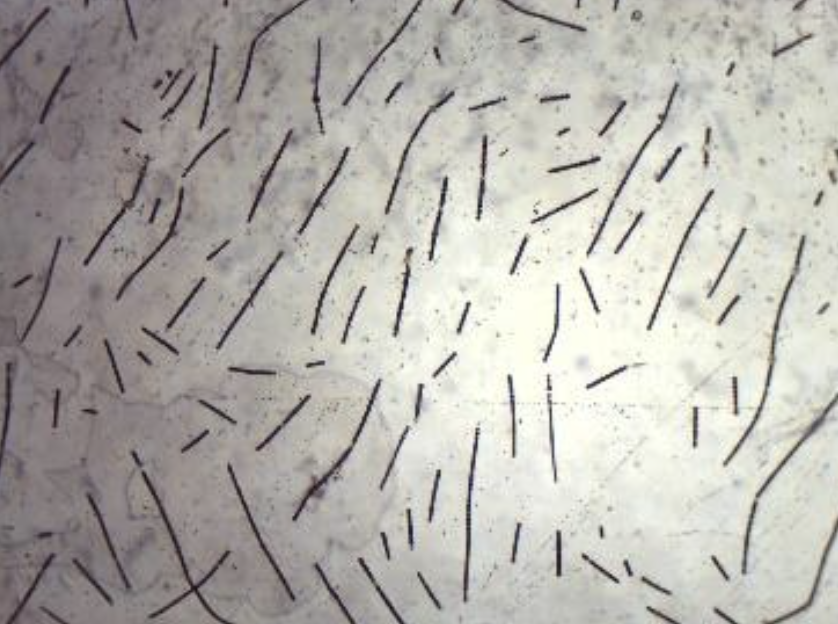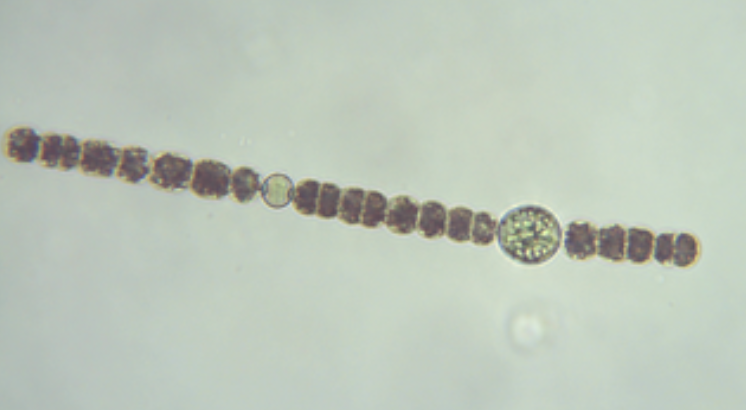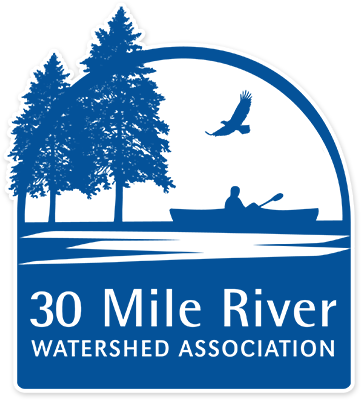Androscoggin Lake: Algal Bloom Response
Latest Updates
Please read our Frequently Asked Questions (FAQ’s) and see below for updates and information.
2025 WATER QUALITY UPDATES:
11/13/2025
Secchi Disk Transparency (water clarity) reading of 2.99 meters. Androscoggin Lake is no longer experiencing a lake wide algal bloom (<2 meters). While the clarity has improved from our previous reading, we continue to receive reports of accumulating algal scum along shorelines. Cyanobacteria may release toxins, with the highest concentrations found in scums. These scums should be avoided.
On November 10th, Executive Director Lidie Robbins spoke at Wayne Presents! Androscoggin Lake Algal Bloom forum. She shared updates on the ongoing efforts to understand the blooms and find management solutions. The discussion covered understanding what a bloom is and potential causes, essential data collection, ongoing projects to reduce phosphorus, and the next steps for collaborative management and community action to protect the lake’s water quality. Other speakers included Ted Tucci, ALIC’s President, sharing ways the community can get involved, and Matt Scott, retired DEP lake expert, discussing other lakes that have struggled with algal blooms.
Approximately 150 attended the event (in-person and online). The program was followed by a comments/question-and-answer period. We are working on sharing the answers to these questions and will provide an update when they become available.
Please see below for other updates and information.
10/30/2025
Secchi Disk Transparency (water clarity) reading of 2.24 meters. Androscoggin Lake is no longer experiencing a lake wide algal bloom (<2 meters). While the clarity has improved from our previous reading, we continue to receive reports of accumulating algal scum along shorelines. Cyanobacteria may release toxins, with the highest concentrations found in scums. These scums should be avoided.
Please see below for other updates and information.
10/14/2025
Secchi Disk Transparency (water clarity) reading of 1.69 meters. While the clarity has improved from our previous reading, we continue to receive reports of accumulating algal scum along shorelines. Cyanobacteria may release toxins, with the highest concentrations found in scums. These scums should be avoided.
Please see below for other updates and information.
10/2/2025
Secchi Disk Transparency (water clarity) reading of 1.30 meters. While the clarity has improved from our previous reading, we continue to receive reports of accumulating algal scum along shorelines. Cyanobacteria may release toxins, with the highest concentrations found in scums. These scums should be avoided.
On 9/24/2025, 30 Mile staff accompanied Maine DEP staff to collect additional samples. The results of these collections have concluded the dominant type of algae causing this bloom is a species of cyanobacteria called Dolichospermum. This is the most common bloom-forming species in Maine lakes and is the same species responsible for the blooms in 2021, 2023, and 2024. It is also concluded that there is a detectable amount of microcystin in the lake caused by this species of cyanobacteria, found both at our regular monitoring station and within scum samples collected at the shoreline.
Please see below for other updates and information.
9/18/2025
Secchi Disk Transparency (water clarity) reading of 0.95 meters. We do not recommend swimming in any areas of the lake when the water clarity declines below 1 meter at our regular monitoring location. We continue to receive reports of accumulating algal scum along shorelines. Cyanobacteria may release toxins, with the highest concentrations found in scums. These scums should be avoided.
30 Mile staff has collected algal samples at scum locations in addition to our regular monitoring station for cyanotoxin and taxonomy analysis. Please see below for other updates and information.
9/2/2025
Secchi Disk Transparency (water clarity) reading of 0.96 meters. We do not recommend swimming in any areas of the lake when the water clarity declines below 1 meter at our regular monitoring location. Please see below for other updates and information.
8/19/2025
Secchi Disk Transparency (water clarity) reading of 1.84 meters. Please see below for other updates and information.
8/15/2025
Conditions on Androscoggin Lake have now reached “lake-wide algal bloom” status, with the most recent Secchi Disk Transparency (water clarity) reading taken on 8/15/2025 at just 1.85 meters. The state of Maine defines the threshold for a “lake-wide algal bloom” at 2 meters and a “harmful algal bloom” (or HAB) at 1 meter of water clarity.
The dominant type of algae causing this bloom is not yet confirmed. In 2024, 2023, and 2021, the algae were identified to be a species of cyanobacteria called Dolichospermum. This is the most common bloom-forming species in Maine lakes. Under certain conditions, this type of cyanobacteria can release toxins that are harmful to animals and humans. The reasons cyanobacteria produce toxins is not well understood, and standard monitoring techniques cannot predict when a bloom has toxins in it. Please refer to this Maine DEP webpage for more information and follow these guidelines:
- Do not accidentally ingest or drink lake water during a bloom. Well-maintained domestic water treatment systems may make lake water safe to drink by removing bacteria and parasites, but they are not guaranteed to remove algal toxins.
- If you shower with lake water, keep showers brief because breathing toxins in shower mist could cause health issues.
- Do not swim, water ski, or boat in areas where algae are visible (e.g., pea soup, floating mats, scum layers, etc.), where water is discolored, or where musty odors are present.
- Rules of thumb: if you are standing in water chest deep (4-5 feet ) and you can’t see your toes because the water is so green, you should get out; if you are looking into water that is 4-5 feet deep and can’t see the bottom of the lake because the water is so green, you should not to go in.
- Because algal scums along the shoreline have the highest concentrations of toxins, do not let children play in water that is discolored, where you see mats of algal material, foam, or where musty odors are present. Do not allow pets or livestock to swim or drink water from these areas.
- Rinse off with fresh water and soap if available, as soon as practical if exposed to water that has dense algae present. This will reduce skin exposure for humans and pets.
Please be aware that bloom conditions on your shoreline and throughout the open waters of the lake can change from day to day (or even by the hour) depending on the wind. If water clarity declines below 1 meter at our regular monitoring location, then we do not recommend swimming in any areas of the lake. For the most recent Secchi disk readings, please visit our website: https://30mileriver.org/androscoggin-lake/.
30 Mile will update this webpage as information becomes available-
please check back for more updates!
Background
Androscoggin Lake experienced a severe cyanobacteria bloom in the summer of 2021 and 2023. Near-bloom conditions were documented in 2022. Maine Department of Environmental Protection (Maine DEP) defines a “lake-wide algal bloom” when water clarity <2 meters (~6 feet) depth at the deepest point in the lake (monitoring station #1).
What you need to know:
- The blooms in Androscoggin Lake have consisted of cyanobacteria (formerly called blue-green algae)
- Cyanobacteria bloom when there’s too much phosphorus in the lake.
- Some species of cyanobacteria can produce toxins under certain conditions
- Not all cyanobacteria blooms are toxic
- Areas where the algae have concentrated, forming dense scums or accumulations, should be avoided by humans, pets, and livestock
- Avoid swallowing lake water while swimming, and do not allow pets or livestock to drink lake water
- Avoid using lake water for household uses, cooking, or drinking
- Shower and wash swimsuits after swimming
What causes algal blooms?
Cyanobacteria rely on three things: light, temperature, and nutrients. When it rains, phosphorus enters the lake via stormwater runoff that is delivered from the land in the watershed surrounding the lake. Phosphorus is a naturally occurring nutrient found in soil, fertilizers, pet and livestock waste, and septic systems among other sources. It is found in very small amounts in the lake water, but is found in very large amounts on land in the watershed surrounding the lake. Every time it rains, water flows over the land and flows downhill – into the ditches, streams, and Androscoggin Lake. When too much phosphorus enters the lake, excess algae growth occurs.
Another important source of phosphorus is the sediments at the lake bottom. In the summer months, low oxygen levels in the deep waters of the lake can cause a chemical reaction to occur in the sediment. This reaction causes the sediment to release phosphorus into the water — a phenomenon known as “internal phosphorus loading”. To learn more, please read Androscoggin Lake’s 2023 Water Quality Report here: https://30mileriver.org/androscoggin-lake/.
For more information about algae blooms and cyanobacteria, please visit Maine DEP’s informational webpages via the following links:
Algal Bloom Information
What are cyanobacteria?
Cyanobacteria are a type of algae. Formerly called blue-green algae, cyanobacteria are aquatic bacteria that are able to photosynthesize. Originally called blue-green algae because dense blooms will turn the water green, or blue-green in color, cyanobacteria are a natural and important part of the lake ecosystem, and can be found in all lakes all over the world. However, when nutrient (phosphorus) concentrations are high enough and conditions are just right, their population can explode. The result is what we call a “cyanobacteria bloom” or “algal bloom.”

What kind of cyanobacteria is it?
The species of cyanobacteria have been identified as Dolichospermum (formerly known as Anabaena), a common bloom-forming species in Maine lakes. Microscope photos (right, courtesy of R. Windecker) show the filamentous algae consisting of multiple bead-like cells of three distinct cell types. Dolichospermum can produce toxins under certain environmental conditions.

Is the water toxic?
We do know that the species causing this bloom has the ability to produce toxin. We are collecting water samples for toxin analysis by US EPA, however test results are not immediate.
Maine DEP has been testing for cyanotoxins in Maine lakes for decades. Of all the toxin samples Maine DEP has collected, there were only a few open-water samples that exceeded EPA’s Drinking Water standard for the algal toxin microcystin for infants and non-school-age children. None of the samples exceeded the standard for school-age children or adults. No open water samples have exceeded EPA’s Recreational Standard – even when collected from lakes with blooms that are chronic and severe.
However, Maine DEP has detected very high concentrations of the algal toxin microcystin in down-wind algal scums that can accumulate along shorelines. This is why we advise everyone to stay away from any concentrated scums or accumulations near shorelines or in down-wind coves. Do not inadvertently drink the water in these areas, and do not let small children, pets, or livestock play in these areas or drink from the lake. Shower after swimming, and do not use lake water for household uses like cooking or drinking.
Out of an abundance of caution: When in Doubt -Stay Out!
What you can do RIGHT NOW to help:
-
- Donate to 30 Mile to support our water quality monitoring program and our work to address this problem: https://30mileriver.org/ways-to-give/
- Become a member of the Androscoggin Lake Improvement Corporation (ALIC) https://androscogginlake.org/alic/how-to-help/donate/
- Be an advocate for lake protection at the town level. Local select boards, planning boards, and code enforcement officers all make decisions that can impact the lake.
- Share this information with your friends, family and neighbors. Be an ambassador for the lake!
- Address erosion on your property. Exposed soil delivers phosphorus to the lake each time it rains. Phosphorus feeds algae in the lake!
- If you are a landowner with an erosion site identified during the 2022 watershed survey, contact 30 Mile to see what cost-sharing opportunities are available to help implement your project!
- Establish or improve the vegetation on your shoreline. The bigger (wider) your shoreline buffer, the better it is for Androscoggin Lake.
- Do you live on a camp road? Gravel roads can be a huge polluter of the lake when sediment and pollutants from the road flow into streams and lakes during rain events. Be sure that your road isn’t part of the problem. Contact 30 Mile for technical assistance and learn more about how to maintain your road and protect the lake: https://www.maine.gov/dep/land/watershed/camp/road/gravel_road_manual.pdf
- Become LakeSmart! Contact ALIC’s LakeSmart team to receive a FREE property visit to learn more about how you can improve your property for the benefit of Androscoggin Lake. Visit https://www.lakes.me/lakesmart to learn more about this fantastic statewide program!
- Stop using fertilizers on your lakefront properties
- Maintain a healthy septic system, and pump your septic tank regularly. Visit https://30mileriver.org/septic-system-vulnerability-study/ to learn more about proper septic maintenance and go through our questionnaire to learn what else you can do to properly maintain your system.
- Volunteer. Help support water quality monitoring and LakeSmart. Sign up here: https://30mileriver.org/volunteer/
Learn more about how you can reduce your impact by visiting Maine DEP’s website for Shorefront Property Owners: https://www.maine.gov/dep/land/watershed/camp/index.html or Maine Lake’s Lake Library: https://www.lakes.me/library.
Near-Live Water Quality Data & Annual Monitoring Reports
30 Mile continues to monitor Androscoggin Lake into October to document improved conditions in the lake. Over the winter months, we will analyze the data and compile our findings into an annual water quality monitoring report, which will be available via our website once complete.
In the meantime, be sure to check out the Secchi disk and dissolved oxygen data collected throughout this year’s monitoring season by visiting 30 Mile’s water quality webpage for Androscoggin Lake: https://30mileriver.org/androscoggin-lake/.
